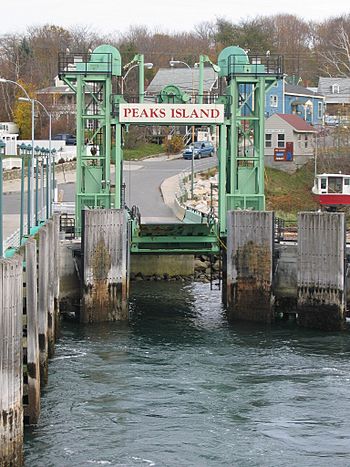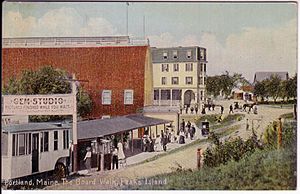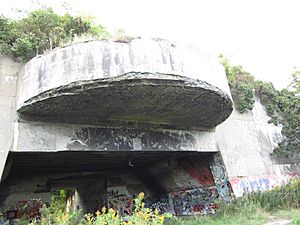Peaks Island facts for kids

Photo of ferry landing and Welch Street on Peaks Island, Maine
|
|
| Geography | |
|---|---|
| Location | Casco Bay, Maine |
| Coordinates | 43°39′25″N 70°11′46″W / 43.65694°N 70.19611°W |
| Adjacent bodies of water | Gulf of Maine |
| Area | 720 acres (290 ha) |
| Demographics | |
| Population | 927 (2011-2015) |
Peaks Island is a popular island in Casco Bay, Maine. It's the island with the most people living on it in the bay. This island is part of the city of Portland and is about three miles from downtown Portland. You can get there by ferry using Casco Bay Lines. Peaks Island has its own elementary school, library, and even a police station. Because it's a larger island, it's the only one in Casco Bay where cars are allowed.
Even though it's small, Peaks Island has many fun places to visit. You can find an ice cream parlor, restaurants, a grocery store, and places to rent kayaks or golf carts. There are also art galleries, the Fifth Maine Regiment Museum, and the unique Umbrella Cover Museum.
The island has had several names over time. It was first called Pond Island. Later, it became Michael's Island, named after Michael Mitton. Then it was known as Munjoy's Island, for George Munjoy, and Palmer's Island, for John Palmer.
Contents
Famous Visitors and Places
Many famous people visited Peaks Island. George M. Cohan, a well-known Broadway producer, would try out his plays at the island's Gem Theater before showing them in New York City. Actress Jean Stapleton had her first professional acting job in 1941 at the Greenwood Garden Playhouse on the island. Martin Landau, another famous actor, also started his professional stage career there in 1951.
Sadly, the Gem Theater was destroyed by a fire on September 7, 1934. Another big fire in 1936 burned down the Union House Hotel and several stores on Island Avenue. These included a restaurant, a grocery store, a bakery, a gift shop, and eight cottages.
During World War II, Peaks Island was an important military defense spot. It had a large military base, including a huge structure called Battery Steele. This battery held two very powerful 16-inch (406-mm) guns. When these guns were first tested, the sound was so strong that windows on the other side of the island shattered!
Island Population
In 2017, about 858 people lived on Peaks Island year-round. However, during the summer, the population grows a lot. Between 2,000 and 4,000 more people come to stay on the island for their vacations.
Efforts to Become a Separate Town
Over the years, there have been several times when people on Peaks Island wanted to separate from the city of Portland and become their own town. This is called "secession." These efforts happened in 1883, 1922, 1948, 1955, 1992, and most recently from 2004 to 2011.
Why Islanders Wanted to Secede
The most recent effort to secede started because property taxes on Peaks Island went up a lot, by over 200 percent. This made many island residents upset. They formed a group to explore becoming a separate town. They gathered enough signatures to have a vote on the island. On June 13, 2006, over 57 percent of the islanders voted in favor of secession.
Discussions and Challenges
The city council of Portland did not want Peaks Island to leave. The islanders and the city council tried to talk about the issue, but they couldn't agree on how to negotiate. In 2007, the secession group tried to get a law passed in the Maine State Legislature to make Peaks Island its own town. After many discussions, the bill was put aside and did not pass.
Working with the City
Because of the secession debate, the Portland City Council agreed to create a special group called the Peaks Island Council. This council was meant to help the islanders talk directly with the city. However, in 2010, most members of this council quit. They felt that Portland was not willing to work with them. The council stopped working properly.
Renewed Efforts and Setbacks
When the political control in the Maine legislature changed, the idea of secession gained new energy. A new bill was introduced in 2011 for another island-wide vote in January 2012. But during hearings, it became clear that not all islanders agreed on secession. The State and Local Government Committee rejected the bill. They said the secession leaders needed to follow the legal steps again, like gathering signatures and holding another vote.



